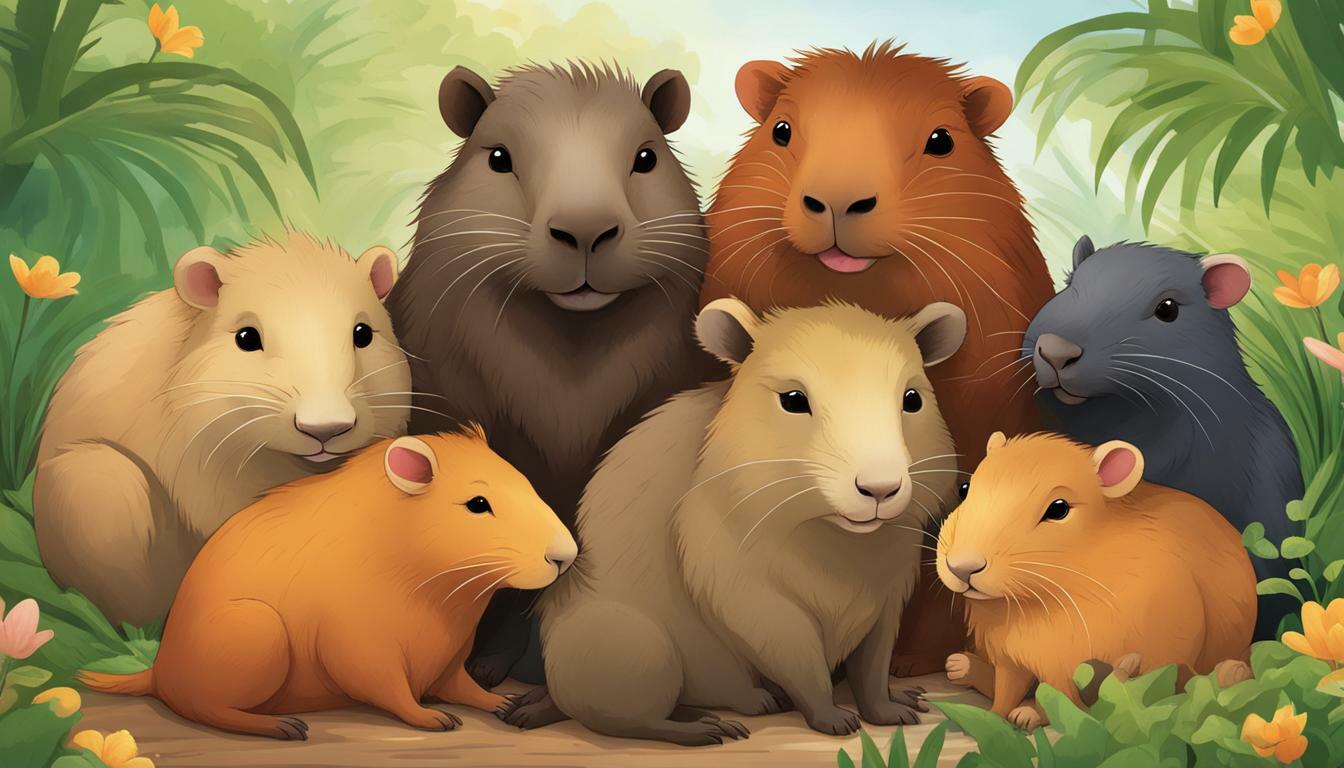Capybaras, the world’s largest rodent, have gained a reputation for their extraordinary friendliness and sociable nature. These adorable creatures live in groups and are herbivores, making them harmless to other species. They possess a high level of tolerance and are known to be comfortable around humans, as long as they are treated with respect and kindness. Capybaras are often seen forming unlikely friendships with a variety of animals, such as cats, monkeys, and even crocodiles. Their nurturing instincts also lead them to adopt orphaned animals, displaying their affectionate and caring nature.
Key Takeaways:
- Capybaras are the largest rodents in the world and are known for their friendliness.
- They live in groups, are herbivores, and pose no threat to other species.
- They are highly tolerant and enjoy the company of humans, as long as they are not harmed.
- Capybaras form surprising friendships with cats, monkeys, and even crocodiles.
- They have a nurturing nature and often adopt orphaned animals.
The Social Behavior of Capybaras
Capybaras are highly social animals that live in groups and display remarkable communication skills. They have a natural inclination to be in the company of their own kind, forming close-knit communities that provide them with a sense of safety and companionship. Within these groups, capybaras engage in various social behaviors that contribute to their friendly nature.
Communication plays a vital role in capybara socialization. These herbivorous mammals use a combination of vocalizations, body language, and scent marking to convey messages and establish social hierarchies. Their vocal repertoire includes purring, barking, and whistling sounds, enabling them to communicate with their fellow capybaras effectively.
When interacting with humans, capybaras often display curiosity and a willingness to socialize. They are known to approach people calmly, especially when they are in an environment where they feel safe. However, it is important to remember that capybaras are wild animals and should be treated with caution and respect to avoid any potential harm.
| Social Behavior of Capybaras | Description |
|---|---|
| Socialization | Capybaras thrive in groups, forming strong social bonds within their communities. |
| Communication | They use vocalizations, body language, and scent marking to convey messages and establish social hierarchies. |
| Curiosity towards humans | When they feel safe, capybaras may approach humans calmly and exhibit a friendly demeanor. |
The social behavior of capybaras extends beyond their own species. They have been observed adopting orphaned animals, demonstrating their nurturing nature and willingness to care for others. Capybaras have formed surprising friendships with animals such as cats, monkeys, and even crocodiles, showing their immense tolerance and ability to coexist peacefully with different species.
In conclusion, capybaras’ friendly nature and sociability are a result of their strong social bonds within their communities and their remarkable communication skills. While they show curiosity towards humans and engage in social interactions, it is crucial to remember that capybaras are wild animals and should be treated with respect. Their ability to form unique relationships with various species showcases their adaptability and open-mindedness in embracing diverse companionship.
Capybaras as Animal Adopters
Capybaras often serve as surrogate mothers for abandoned or orphaned animals, showcasing their caring instincts. With their gentle and friendly nature, capybaras readily accept and care for a variety of species, from kittens and puppies to monkeys and even baby crocodiles. This unique behavior has captured the attention and admiration of many animal lovers around the world.
It is not uncommon to see capybaras adopting stray animals and providing them with the love and protection they need. Their calm and nurturing temperament, combined with their strong maternal instincts, make them excellent caregivers. Capybaras form strong bonds with the young animals they adopt, providing them warmth, comfort, and the necessary socialization they require.
One of the reasons capybaras are such exceptional animal adopters is their natural inclination to live in close-knit family groups. These groups, known as herds, consist of multiple individuals, including adults and their offspring. In these herds, capybaras exhibit strong social bonds and engage in behaviors that promote group cohesion and caring for one another. This inherent sense of community extends beyond their own species, allowing them to readily accept and care for other animals in need.
| Benefits of Capybara Adoption | Examples of Adopted Animals |
|---|---|
| Emotional support and companionship | Kittens |
| Protection from predators | Puppies |
| Teaching essential survival skills | Monkey infants |
| Regulating body temperature | Baby crocodiles |
Through their remarkable ability to nurture and care for other animals, capybaras have shown us the depth of their empathy and compassion. Their selfless acts of motherhood not only benefit the adopted animals but also serve as a testament to the innate characteristics of the capybara species.
Capybaras’ Interactions with Other Species
Capybaras have been observed engaging in playful interactions with a diverse range of animals, fostering unlikely friendships. These friendly creatures seem to have a special charm that attracts other species, including cats, monkeys, and even crocodiles.
One of the most fascinating examples of capybaras’ social nature is their relationship with cats. Despite their differences in size and species, capybaras and cats often form close bonds, lounging together and grooming each other. This unusual friendship showcases the peaceful nature of capybaras.
Capybaras also display surprising interactions with monkeys. In some regions, monkeys have been seen riding on the backs of capybaras, using them as a form of transportation. This cooperative behavior demonstrates the willingness of capybaras to interact and share their space with other animals.
Perhaps the most remarkable and unexpected display of friendship is between capybaras and crocodiles. In certain locations, capybaras and crocodiles can be seen sunbathing together, with the capybaras even resting on top of the crocodiles. This unlikely companionship showcases the friendly and accepting nature of capybaras, even towards predators.
| Unlikely Animal Friends: |
|---|
| Capybaras and cats |
| Capybaras and monkeys |
| Capybaras and crocodiles |
Capybaras’ Contribution to Animal Care
Capybaras contribute to the overall well-being of other animals by serving as a source of nourishment and grooming assistance. As herbivores, their diet consists mainly of grasses and aquatic vegetation, making them an ideal food source for animals like birds, reptiles, and smaller mammals. By allowing these animals to feed on their fur for lice and ticks, capybaras provide a valuable grooming service that helps maintain the health and cleanliness of their fellow creatures.
In addition to their role as a source of food and grooming, capybaras also play a significant social role in animal care. They are known for their nurturing nature and have been observed adopting orphaned animals from various species. Whether it’s a lost duckling, a baby monkey, or even a young crocodile, capybaras readily take on the role of surrogate mothers, providing warmth, protection, and a sense of belonging to these orphaned creatures.
It is fascinating to witness the bond that forms between capybaras and their adopted children. The young animals often follow their capybara parent closely, mimicking their behaviors and seeking comfort and security within the family unit. This unique cross-species relationship highlights the compassionate and caring nature of capybaras.
| Benefits of Capybaras’ Contribution to Animal Care: | Examples |
|---|---|
| Capybaras provide a source of nourishment for other animals | Wild birds feed on the grasses in their diet |
| Capybaras offer grooming assistance to other animals | Small mammals tackle lice and ticks found in the capybaras’ fur |
| Capybaras adopt orphaned animals from various species | A lost duckling finds a new family with a capybara |
Capybaras’ Calm and Cuddly Nature
Capybaras are known for their gentle and docile nature, often enjoying cuddling sessions and frolicking in water. Their calm temperament makes them a favorite among animal lovers seeking a companion that can provide affection and relaxation. Whether it’s a fellow capybara or a human, these furry creatures have a knack for creating a sense of tranquility.
These adorable rodents are highly sociable, forming close-knit groups and seeking comfort in the presence of their own kind. Their preference for companionship extends to humans as well, as they delight in interacting with people and forging bonds. Capybaras have a knack for sensing the emotional needs of those around them, offering solace and warmth through their cuddling sessions.
Water is an integral part of a capybara’s life, and they take immense pleasure in swimming and splashing around. Their large webbed feet and streamlined bodies make them excellent swimmers, allowing them to navigate through water effortlessly. Whether it’s a natural body of water or a specially designed enclosure, capybaras are often seen basking in the joy of aquatic adventures, indulging in their innate love for water.
The Comfort of Cuddles
Capybaras are not just content with swimming and socializing; they also seek comfort in cuddling. These affectionate creatures have a natural inclination towards physical closeness and find solace in nuzzling and snuggling with their companions. It’s not uncommon to find capybaras huddled together, creating small piles for warmth and protection. Their calm and cuddly nature makes them a perfect source of comfort for both humans and other animals.
Affectionate and Adaptable
Whether it’s their friendly interactions with other species or their ability to provide care and nourishment to fellow animals, capybaras showcase their affectionate and adaptable nature. They forge remarkable friendships with cats, monkeys, and even crocodiles, defying expectations and demonstrating their capacity for tolerance and acceptance. Additionally, these adorable creatures contribute to animal care by allowing other animals to groom their fur, providing a valuable service while building bonds of trust and companionship.
| Capybara Characteristics |
|---|
| Known for gentle and docile nature |
| Enjoy cuddling and frolicking in water |
| Highly sociable and seek companionship |
| Love interacting with humans |
| Excellent swimmers with webbed feet |
| Find comfort in cuddling and snuggling |
| Foster friendships with various species |
| Contribute to animal care through grooming |
Capybaras’ Intelligence and Trainability
Capybaras demonstrate remarkable intelligence and can be trained to learn various tasks and behaviors. Their ability to quickly grasp new concepts and respond to training makes them a popular choice among animal trainers and enthusiasts.
One of the key factors contributing to their trainability is their social nature. Capybaras are highly sociable animals that live in groups, allowing them to observe and learn from one another. This social intelligence enables them to understand and follow commands given by their human trainers.
When it comes to training, capybaras are capable of learning a wide range of behaviors. They can be taught to perform tricks, such as sitting, rolling over, and even playing games. With positive reinforcement techniques and consistent training, capybaras can become well-behaved and obedient companions.
However, it is important to remember that their intelligence and trainability should be handled responsibly. Capybaras are still wild animals with their own instincts and natural behaviors. Training should always be based on trust and respect, ensuring the well-being and safety of both the capybara and the trainer.
| Benefits of Training Capybaras | Considerations for Training Capybaras |
|---|---|
|
|
Capybaras are intelligent and trainable animals. With patience, consistency, and respect for their natural instincts, they can become well-behaved companions and even participate in various therapy or educational programs. Training a capybara requires a good understanding of their social nature and the use of positive reinforcement techniques.
Capybaras’ Preference for Their Own Kind
While capybaras are friendly towards humans, they have a strong preference for spending time with their fellow capybaras. These social creatures thrive in groups, known as herds, and their well-being is closely tied to their interactions with one another. Capybaras engage in various social behaviors that strengthen their bonds and establish a sense of belonging within the herd.
One fascinating aspect of capybara social behavior is their tendency to sleep in piles for warmth and protection. This close physical contact not only provides comfort but also reinforces their social connections. Within the herd, capybaras form distinct family units, which often consist of a dominant male, several females, and their offspring. These families engage in mutual grooming, cuddling, and play, further solidifying their social bonds.
To better understand the structure of capybara herds, let’s take a look at a typical capybara family:
| Family Member | Role/Characteristic |
|---|---|
| Dominant male | Leader and protector of the family |
| Females | Mothers and caretakers of the offspring |
| Offspring | Dependent on their mother and siblings for care and protection |
In addition to their familial connections, capybaras also establish social hierarchies within the herd. Dominance is often determined through vocalizations and physical interactions, such as nose-to-nose sniffing and mounting. These behaviors help maintain order and reduce the likelihood of conflicts within the group.
While capybaras enjoy the company of their own kind, they are generally accepting of other herbivorous species. In certain cases, capybaras have been observed forming social bonds with animals such as cats, monkeys, and even unlikely companions like crocodiles. These cross-species friendships highlight the friendly and adaptable nature of capybaras, as they recognize the benefits of social interaction beyond their own species.
Key Points:
- Capybaras have a strong preference for spending time with their fellow capybaras.
- Social behaviors, such as mutual grooming and cuddling, strengthen the bonds within capybara herds.
- Capybara families consist of a dominant male, females, and their offspring, with each member playing a distinct role.
- Dominance within the herd is established through vocalizations and physical interactions.
- Capybaras are generally accepting of other herbivorous species, forming cross-species friendships in certain cases.
Capybaras’ Family Dynamics
Capybaras form tight-knit family units and often sleep in piles, providing comfort, warmth, and protection to one another. These adorable creatures are known for their social nature and their strong affinity for their family members. In fact, capybara families are so close that they spend a significant amount of time cuddling together, reinforcing their bond and creating a sense of security.
Within a capybara family, there is a defined hierarchy, with the dominant male and female leading the group. Other family members, including offspring and extended relatives, respect and follow the lead of the dominant pair. This structure ensures order and cooperation within the family unit, allowing capybaras to thrive in their natural habitats.
In addition to their close familial relationships, capybaras also engage in communal care for their young. It is not uncommon to see multiple adult capybaras, including siblings and other relatives, taking turns to watch over and protect the young ones. This shared responsibility allows for the development of strong bonds and teaches the younger capybaras important life skills from multiple sources.
| Capybara Family Dynamics | Description |
|---|---|
| Sleeping in Piles | Capybaras sleep in piles, providing comfort, warmth, and protection to one another. |
| Established Hierarchy | There is a defined hierarchy within a capybara family, led by the dominant male and female. |
| Communal Care | Capybaras engage in communal care for their young, with multiple adults taking turns to watch over and protect them. |
These close-knit family dynamics contribute to the overall well-being of capybaras. By working together and relying on one another, capybaras can better navigate their environments and ensure the survival of their species. The strong bonds formed within their families also provide emotional support and a sense of belonging, fostering a harmonious and fulfilling social life for these remarkable creatures.
Capybaras as Wild Animals
It is crucial to understand that capybaras are inherently wild animals and require appropriate care and respect. While their friendly and sociable nature might make them appear suitable as pets, it is important to remember that capybaras have specific needs that can be challenging to meet in a domestic setting.
Being the largest rodents in the world, capybaras need ample space to roam and access to water for swimming, as it is an essential part of their natural behavior. A small backyard or indoor environment may not provide the necessary environment to support their physical and psychological well-being.
| Key Points: |
|
|---|
“While their friendly and sociable nature might make them appear suitable as pets, it is important to remember that capybaras have specific needs that can be challenging to meet in a domestic setting.”
In addition, capybaras have specialized dietary requirements. Being herbivores, they need a diet that consists mainly of fresh vegetation, including grasses and aquatic plants. Providing a balanced and suitable diet might be difficult for a pet owner without access to a variety of suitable food sources.
| Key Point: | Meeting the dietary needs of capybaras may be challenging for a pet owner. |
|---|
Furthermore, capybaras are highly social animals that thrive in groups. Their well-being is closely tied to social interactions, and they may experience loneliness and stress when kept alone. Creating an appropriate social environment with other capybaras would be essential for their happiness and overall health.
| Key Point: | Socialization with other capybaras is crucial for their well-being. |
|---|
While capybaras are undoubtedly fascinating animals with their friendly nature and unique behaviors, it is vital to respect their wild nature. They should be observed and appreciated in their natural habitats or under the care of experienced professionals who can provide them with the necessary environment and care they require.
| Key Point: | Capybaras are best appreciated and observed in their natural habitats or under professional care. |
|---|
Summary:
Capybaras, with their friendly and sociable nature, might seem like appealing pets. However, it is important to recognize that they are inherently wild animals. They need a large space to roam, water for swimming, a specialized diet, and social interactions with their own species. Their specific needs can be challenging to meet in a domestic setting. Therefore, it is crucial to respect their wild nature and appreciate them either in their natural habitats or under the care of professionals who can provide the suitable environment they require.
Capybaras and Human Interaction
Capybaras are generally amicable towards humans and often find joy in engaging with them. With their friendly and sociable nature, capybaras have become popular animals for interaction and observation. Despite being the largest rodents in the world, capybaras pose no threat to humans and are highly tolerant of their presence.
One of the reasons capybaras are so popular is their ability to form bonds with humans. They are known to seek out human companionship and enjoy being petted and groomed. Capybaras have a calm temperament and are often seen peacefully coexisting with humans in parks and nature reserves.
It is not uncommon to find capybaras interacting with humans in various settings. They have been observed playfully chasing after balls or joining in picnics by the water. Capybaras’ playful nature and curiosity make them a delightful companion for humans of all ages. However, it is important to remember that although capybaras are friendly, they are still wild animals and should be treated with respect and caution.
While capybaras are known for their positive interactions with humans, it is crucial to ensure their well-being and safety. Visitors should be mindful of their behavior around capybaras, avoiding any actions that may cause stress or discomfort to these gentle creatures. By respecting their natural behavior and habitat, humans can continue to enjoy the unique and heartwarming interactions with these friendly animals.
| Positive Interactions with Humans | Cautions and Considerations |
|---|---|
|
|
Conclusion
Capybaras’ exceptional friendliness, social behavior, and nurturing instincts contribute to their reputation as lovable and approachable animals. These gentle giants, the largest rodents in the world, live in groups and are known for their sociability. They are highly tolerant and pose no threat to other species, making them a favorite among other animals.
Capybaras are often seen interacting with various species, including cats, monkeys, and even crocodiles. Their friendly nature extends beyond their own kind, as they have been known to adopt orphaned animals as their own, showcasing their nurturing instincts.
Not only are capybaras friendly towards animals, but they also enjoy the company of humans. They are highly intelligent and can be trained to perform tricks and follow commands, adding to their charm. Capybaras’ calm and affectionate nature make them ideal companions for interactive activities, such as cuddling and water-based adventures.
While capybaras prefer the company of their own kind and exhibit close-knit family dynamics, they are still welcoming towards humans. They enjoy interacting with people and are tolerant as long as they are not harmed. However, it is important to remember that capybaras are wild animals and should not be treated as domesticated pets. Respect for their natural instincts and habitat is crucial for their well-being.
FAQ
Why are capybaras known for being friendly?
Capybaras are known for being friendly due to their sociable nature and tolerance towards other species, including humans. They pose no threat and are often seen interacting with various animals.
Are capybaras suitable as pets?
While capybaras can be friendly towards humans, they are still wild animals and should not be treated like domesticated pets. It is important to respect their natural instincts and characteristics.
Do capybaras adopt orphaned animals?
Yes, capybaras are known to adopt orphaned animals. Their nurturing nature and willingness to care for other species make them exceptional adoptive parents.
What animals do capybaras interact with?
Capybaras are often seen interacting with a variety of animals, including cats, monkeys, and even crocodiles. Their friendly nature allows them to form unlikely friendships.
How do capybaras contribute to animal care?
Capybaras provide food and comfort to other animals by allowing them to groom their fur for lice and ticks. This behavior benefits both capybaras and the animals they interact with.
Are capybaras calm and cuddly?
Yes, capybaras have a calm and affectionate nature. They enjoy cuddling and engaging in water activities, which adds to their endearing qualities.
Can capybaras be trained?
Capybaras are highly intelligent and can be trained to perform tricks and follow commands. Their trainability is another fascinating aspect of their behavior.
Do capybaras prefer the company of their own kind?
Yes, capybaras have a natural inclination to be in the company of their own species. They exhibit strong social preferences towards other capybaras.
What is the family dynamics of capybaras?
Capybaras have a close-knit family structure. They sleep in piles for warmth and protection. Capybara families often cuddle together, further strengthening their bond.
How should capybaras be treated as wild animals?
Despite their friendly nature, capybaras are still wild animals and should not be treated as domesticated pets. It is important to respect their natural instincts and habitats.
How do capybaras interact with humans?
Capybaras are friendly towards humans and enjoy interacting with them. However, it is crucial to approach them without causing harm or distress.




